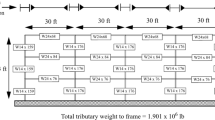Abstract
One of the main problems is the assessment of “residual reliability” or “vulnerability” of a single existing structure, or of a given class of similar structures, against seismic actions. The fragility curves describe the probability of a structure to suffer a given damage level when it is subject to a given seismic excitation level. This research work is focused on an analytical method for constructing fragility curves of existing structures based on a stochastic approach. Analysed structure is modelled by a simple one degree of freedom system subject to a nonstationary Kanai-Tajimi process. The numerical values of the parameters of its constitutive law, here suitably described by means of a hysteretic model, are selected using an identification procedure with the non linear pushover analysis performed on the real assessed structure. To develop fragility curves, a displacement based damage index is adopted. Fragility curves are obtained in terms of probability of exceeding a given damage level by using an approximate crossings theory of stochastic processes.
Similar content being viewed by others
References
Atalik, S. and Utku, T. (1976). “Stochastic linearization of multi degree of freedom non linear systems.” Earthquake Engineering and Structural Dynamics, Vol. 4, pp. 411–420.
Cunha, A.M.F (1984). “The role of the stochastic equivalent linearization method in the analysis of the non linear seismic response of building structures.” Earthquake Engineering and Structural Dynamics, Vol. 23, pp. 837–857.
Ghobarah, A (2001). “Performance-based design in earthquake engineering: state of development.” Engineering Structures, Vol. 23, pp. 878–884.
Ghobarah, A., Abou-Elfath, H., and Biddah, A.(1999). “Response based damage assessment of structures.” Earthquake Engineering and Structural Dynamics, Vol. 28, pp. 79–104.
Jennings, P.C. and Housener, G.W. (1968). “Simulated earthquake motions for design purpose.” Proc. 4th World Conference Earth. Eng., A-1, pp. 145–160.
Kappos, A.J. and Xenos, A.A. (1996). “A reassessment of ductility and energy-based seismic damage indices for reinforced concrete structures.” Proceedings of the 3rd European Conference on Structural Dynamics (Eurodyn’96), Florence, Italy, Vol. 2, pp. 965–970.
Lutes, D.L. and Sarkani, S. (2003). S. Random Vibration, Butterworth-Heinemann, Oxford, UK.
Roberts, J.B. and Spanos, P.D. (1990). Random Vibration and Statistical Linearization, John Wiley & Sons, Ltd, Chichester, England.
Shinozuka, M., Feng, M.Q., Lee, J., and Naganuma, T. (2000). “Statistical analysis of fragility curves.” Journal of Engineering Mechanics, ASCE, Vol. 126, No. 12, pp, 1224–1231.
Soong, T.T. and Grigoriu, M. (1993). Random Vibration in Mechanical and Structural System, N.Y., Prentice-Hall.
Uva, G. and Mezzina, M. (2006). “The r.c. technology in Italy at the beginning of 20th century. A historical journey through the work of the Porcheddu Society.” FIB 2006. ISBN/ISSN: 88-89972-06-8.
Wen, Y.K. (1976). “Method for random vibration of hysteretic systems.” Journal of the Engineering Mechanics Division, ASCE, Vol. 102, pp. 150–154.
Williams, M.S. and Sexsmith, R.G. (1995). “Seismic damage indices for concrete structures: A state-of-the-art review.” Earthquake Spectra, Vol. 11, No. 2, pp. 319–349.
Wong, C.W., Ni, Q.Y., and Ko, J.M. (1994). “Steady-state oscillation of hysteretic differential model. I: Response analysis.” J. Eng. Mech., ASCE, Vol. 120, pp. 2299–2325.
Author information
Authors and Affiliations
Corresponding author
Rights and permissions
About this article
Cite this article
Marano, G.C., Greco, R. & Mezzina, M. Stochastic approach for analytical fragility curves. KSCE J Civ Eng 12, 305–312 (2008). https://doi.org/10.1007/s12205-008-0305-8
Received:
Accepted:
Published:
Issue Date:
DOI: https://doi.org/10.1007/s12205-008-0305-8




